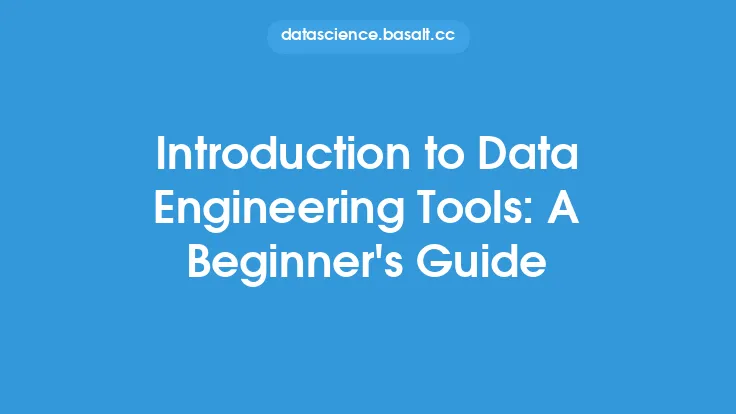As data engineering continues to play a vital role in the success of modern businesses, the importance of maximizing efficiency with data engineering tools cannot be overstated. Data engineering tools are designed to help organizations manage, process, and analyze large volumes of data, and when used effectively, they can significantly improve the speed, quality, and reliability of data-driven decision-making. In this article, we will explore the best practices for maximizing efficiency with data engineering tools, and provide insights into how to get the most out of these powerful technologies.
Understanding Data Engineering Tools
Data engineering tools are a broad category of software applications and platforms that are used to design, build, and manage data pipelines, architectures, and systems. These tools can include data integration platforms, data warehousing solutions, data governance tools, and data quality software, among others. To maximize efficiency with data engineering tools, it is essential to have a deep understanding of the different types of tools available, their capabilities, and their limitations. This includes understanding the various data processing paradigms, such as batch processing, stream processing, and real-time processing, as well as the different data storage options, including relational databases, NoSQL databases, and data lakes.
Designing Efficient Data Pipelines
One of the critical aspects of maximizing efficiency with data engineering tools is designing efficient data pipelines. A data pipeline is a series of processes that extract data from multiple sources, transform the data into a standardized format, and load the data into a target system, such as a data warehouse or data lake. To design efficient data pipelines, data engineers should focus on minimizing data latency, reducing data duplication, and optimizing data processing workflows. This can be achieved by using data pipeline orchestration tools, such as Apache Airflow or Apache Beam, which provide a framework for designing, deploying, and managing data pipelines.
Optimizing Data Processing Workflows
Optimizing data processing workflows is another essential aspect of maximizing efficiency with data engineering tools. Data processing workflows involve a series of tasks, such as data ingestion, data transformation, and data loading, which can be resource-intensive and time-consuming. To optimize data processing workflows, data engineers can use techniques such as parallel processing, distributed processing, and caching, which can significantly improve the speed and efficiency of data processing. Additionally, data engineers can use data processing frameworks, such as Apache Spark or Apache Flink, which provide a set of libraries and APIs for building high-performance data processing applications.
Ensuring Data Quality and Reliability
Ensuring data quality and reliability is critical to maximizing efficiency with data engineering tools. Poor data quality can lead to inaccurate insights, incorrect decisions, and significant financial losses. To ensure data quality and reliability, data engineers should implement data validation, data cleansing, and data normalization techniques, which can help to detect and correct errors, inconsistencies, and inaccuracies in the data. Additionally, data engineers can use data quality tools, such as data profiling and data monitoring, which provide real-time insights into data quality and reliability.
Implementing Data Governance and Security
Implementing data governance and security is essential to maximizing efficiency with data engineering tools. Data governance involves establishing policies, procedures, and standards for managing data across the organization, while data security involves protecting data from unauthorized access, theft, or damage. To implement data governance and security, data engineers should use data governance frameworks, such as COBIT or ITIL, which provide a set of best practices and guidelines for managing data. Additionally, data engineers can use data security tools, such as encryption, access control, and authentication, which provide a secure and reliable way to manage and protect data.
Monitoring and Optimizing Data Engineering Tools
Monitoring and optimizing data engineering tools is critical to maximizing efficiency and ensuring that data pipelines, architectures, and systems are running smoothly and efficiently. To monitor and optimize data engineering tools, data engineers can use monitoring and logging tools, such as Apache Kafka or ELK Stack, which provide real-time insights into data processing workflows, data latency, and data quality. Additionally, data engineers can use optimization techniques, such as performance tuning, capacity planning, and cost optimization, which can help to improve the efficiency, scalability, and reliability of data engineering tools.
Best Practices for Maximizing Efficiency
To maximize efficiency with data engineering tools, data engineers should follow a set of best practices, including:
- Designing efficient data pipelines and architectures
- Optimizing data processing workflows and data storage options
- Ensuring data quality and reliability through data validation, data cleansing, and data normalization
- Implementing data governance and security through data governance frameworks and data security tools
- Monitoring and optimizing data engineering tools through monitoring and logging tools and optimization techniques
- Continuously evaluating and improving data engineering tools and processes through feedback, testing, and iteration.
By following these best practices and using the right data engineering tools, organizations can maximize efficiency, improve data quality and reliability, and make better data-driven decisions. As data engineering continues to evolve and play a critical role in the success of modern businesses, the importance of maximizing efficiency with data engineering tools will only continue to grow.





